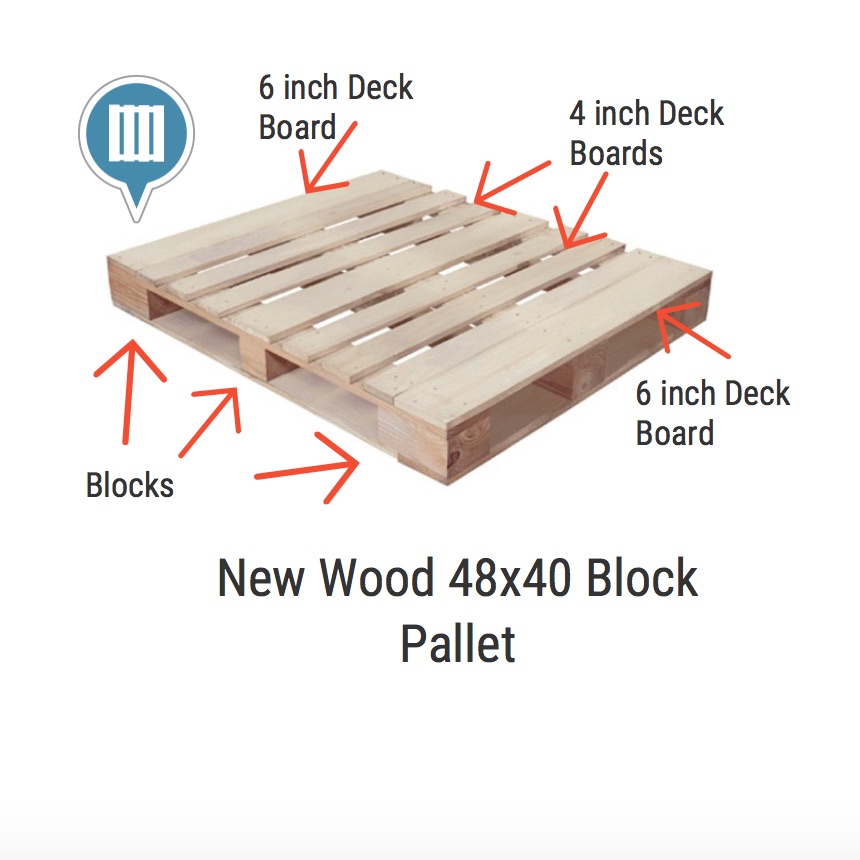How To Identify Repair and Grade Pallets
How To Identify Repair and Grade Pallets

Buy Pallets, Sell Pallets, and Find FREE Pallets at Repalletize
Click here to search the map
Share Your Pallet Buying And Recycling Experience With Your Friends
How To Identify Repair and Grade Pallets
Types of Pallets
Stringer Pallets
The standard sized pallet in the United States is GMA 48 x 40 stringer pallet. This is used by most businesses that ship products on pallets. A stringer pallet has a 3 or more boards that make a frame along the side of the pallet. The deck boards are attached to the top of the stringer boards. There are many types of stringer pallets. Stringer pallet prices are very affordable.
Block Pallets
Block pallets are very popular in large grocery stores like Costco and Sam?s Club. A block pallet is made of 9 blocks that are connected by the deck boards. This makes the block pallet stronger than the stringer pallet. Some grocery stores require you to buy block pallets.

Definitions of Pallet Parts
Pallet Boards
Deck boards: boards that are across the top of the pallet which the products sit on.

Stringer boards: Boards that make up a frame for the pallet. Stringer boards can be solid or have notches that make a 4-way entry pallet.

Lead board: Lead boards are the deck boards at the front and back of the pallet. These boards are typically wider than the middle deck boards. Lead boards are typically 6 inches wide. Lead boards provide strength to the pallet.
Pallet Hardware
Nails: Nails or fasteners are used to keep the pallets together.
Splicer plate: these parts are used to repair broken or cracked boards.
Pallet Terminology
Skid: A skid is a pallet that does not have bottom boards.
Heat treated: Pallets need to be heat treated to prevent the spread of diseases and bugs from lumber products that are shipped internationally .
Deck board spacing: This is the spacing between boards on the top of the pallet.
Notched: Stringers are notched so that a forklift or pallet jack can enter on all 4 sides, otherwise known as a 4-way pallet.
4 way entry: A pallet that can be entered by a forklift on all 4 sides.

2 way entry: A pallet that can be entered by a forklift on 2 sides.
Block pallet: A pallet build with blocks.
48x40: A standard sized pallet.
Damages to Pallets
Here is a list of the most common types of damages to a pallet.Missing parts
Broken boards
Split boards
Missing wood
Repairing Tools for Pallets
Objective: To make the repairing as safe as possible to the employee repairing the pallet and as quickly as possible to reduce the cost of the pallet repairs.
Pry bars
Pallet jack
Air compressor
Nailing equipment
Pallet repair workstation
saws
Pallet Repairing Techniques
Objective: Make a used recycled pallet the same durability and structural integrity as a new pallet. Be sure to follow a wood pallet-recycling guide.
replace missing boards
replace damaged boards
renail loose boards
replace missing nails or screws
make boards flush with pallet
make sure pallet is squared
repair warped pallets

Complete Guide For Grading Pallets
Objective: To determine which pallet will provide the accurate amount of protection for your goods being shipped and the safety of workers.
Appearance of Pallet
Brightness or Grayness of the Wood:
When grading pallets the first step is to look at the appearance of the wood. The brightness or grayness of wood will affect the grading of the pallet. The brighter the wood the higher grade pallet it will receive.
Squared Pallet Deviations:
The appearance of the pallet should be square. When measuring the pallet all corners of the pallet should be square. Any deviations of 1 inch or more are unacceptable and will affect the grade of the pallet.
Cleanliness of the Pallet:
A pallet should be clean from any contamination such as staples, cardboard, paint, grease, or other materials. The cleaner the pallet the higher grade of pallet it will receive.
Stringer Integrity
A pallet should have solid stringers. When grading a pallet you need to look for repairs to stringer boards. Some common repairs to stringer boards are metal mending plates and support boards called companion stringers or plugs. If a pallet stringer has repairs it will affect the grade the pallet receives.
Deck boards
When grading a pallet, there should not be any deck boards or bottom boards missing. There should be 7 top deck boards and 5 bottom boards. In addition to having all the boards present, there should also not be more than a 3.5-inch gap between boards. The front and back deck boards called lead deck boards should be 6 inches wide. The middle deck boards should be 4 inches wide. The thickness of the deck boards should not be less than 9/16 of an inch.
To grade deck boards and bottom boards you need to look for slits or cracks in the wood. You will need to make sure chucks of wood are not missing on end pieces. Be sure to also look to make sure the boards are securely fastened. All of these factors will help determine the grade of the pallets.
Nails
All nails often referred to as fasteners must be completely nailed flush with the wood. Nails that are raised above the deck boards or sticking out of the side of stringers are not acceptable. Any nails not completely nailed in will affect the grade of the pallet.
Types of Grades of Pallets
A Grade Pallets
Pallets that have bright white wood, complete with deck boards, no stringer repairs, and flush nails receive A Grade Pallet Status.
B Grade Pallets
Pallets that have bright white wood mixed with gray or dirty wood, complete with deck boards and some repairs, stringers with repairs, and flush nails receive B Grade Pallet Status.
Number 1 pallets are also considered A grade pallets. While Number 2 pallets are considered B grade pallets.